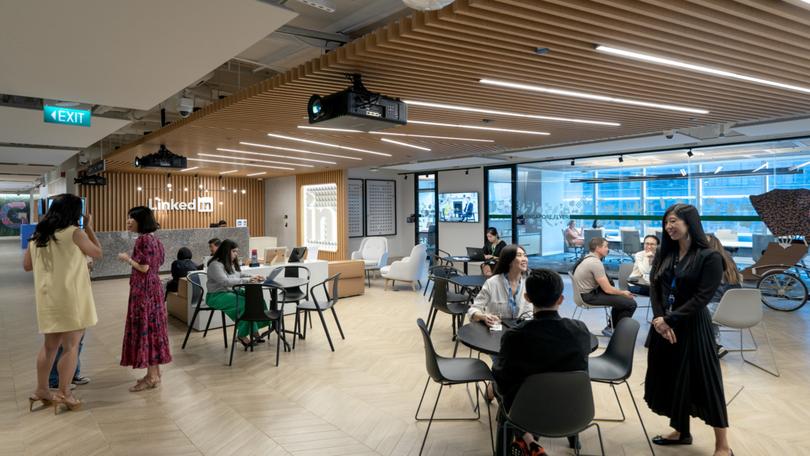THE ECONOMIST: Secrets of LinkedIn success as network’s AI onboarding set to pay off

Congratulate LinkedIn on its work anniversary! Next month the business world’s favourite social network will turn 22. The 1.1 billion users of LinkedIn — which is a year older than even Facebook — can celebrate two decades of humblebrags, motivational quotes and automated congratulations from long-forgotten acquaintances. Microsoft, its owner, can meanwhile toast a canny acquisition. Since the tech giant bought LinkedIn eight years ago, for $US26 billion ($41b) the platform’s annual revenue has grown from $US3b to $US17b.
As LinkedIn matures, two aspects of its business are evolving. First, people are using the platform differently. What used to be simply a contact network is increasingly becoming a content channel. This presents LinkedIn with an opportunity in advertising — but at a risk to its professional identity. Second, LinkedIn is taking on a new strategic function for Microsoft. As the tech giant bets big on artificial intelligence (AI), LinkedIn is providing its owner with a billion willing guinea pigs, perhaps giving it an edge in the ai race.
With its profile pages and newsfeed, LinkedIn looks much like other social networks — until you see the content. Whereas the most followed people on other platforms are athletes and models, the king of LinkedIn is Bill Gates, who treats his 37m followers to posts about subjects as varied as agriculture and tuberculosis. “The stuff that bores people at parties works really well on LinkedIn,” says Dan Roth, who runs its editorial team, citing a recent viral discussion on the merits of em dashes — a worthy subject for debate.
Sign up to The Nightly's newsletters.
Get the first look at the digital newspaper, curated daily stories and breaking headlines delivered to your inbox.
By continuing you agree to our Terms and Privacy Policy.Its business model is also different. Every other social network lives on advertising: Meta, which owns Facebook and Instagram, gets 98 per cent of its revenue from them. LinkedIn sells ads too — $US7b-worth last year, analysts estimate — but makes the largest share of its revenue from its recruitment business. LinkedIn claims that it is the world’s biggest, filling a job vacancy every couple of seconds. The company also made $US2b last year from paid subscriptions, a business no other social network has cracked. Every platform is trying to diversify, says Jeremy Goldman of eMarketer, a data company. “LinkedIn solved that before a lot of them did.”
This success disguises a weakness: although more than 1b people have signed up for LinkedIn, many do not use it all that much. The company does not reveal usage figures. But Sensor Tower, a data provider, estimates that Android-phone users with the LinkedIn app spend an average of only 48 minutes a month on it. For TikTok the figure is around 35 hours.
Lower engagement means fewer chances to show ads, an area where the opportunity for LinkedIn is large. Business-to-business (B2B) advertising, LinkedIn’s speciality, is a laggard in the great move online. Of all advertisements sold in America this year, more than 80 per cent by value will be digital, estimates eMarketer. By contrast, less than half of B2B ads will be. Some $US20b-worth of such ads are ripe to be plucked from offline channels, such as trade journals and conferences, if LinkedIn can make people spend enough time on its platform to see them.
An effort is under way. Three years ago LinkedIn began adjusting its algorithm to show users more content suited to their interests, rather than just from people in their network (think more posts from Mr Gates, fewer from your colleague in accounts). Last year it introduced puzzles. Users get reminders to post more often. Mr Roth’s team cultivates star creators such as the boss of McDonald’s, Chris Kempczinski, who posts deadpan video reviews of the chain’s international dishes (“A very, very lemony taste. You gotta like lemon if you want this Koldskål McFlurry”).

In profile
External factors are helping. People are changing jobs more often, making them more eager to polish their public brand. COVID-19 lockdowns blurred the line between work and home, encouraging more personal posts. Meta’s decision to reduce the visibility of news on its platforms, and X’s feral turn, have also driven conversation to LinkedIn. Comments there have risen by 37 per cent year-on-year; video uploads have increased by nearly as much. This attention is being monetised. LinkedIn’s ad business will grow by 11.6 per cent this year, forecasts eMarketer. Paid membership has risen 50 per cent faster in the past two years.
The flood of content risks trapping LinkedIn into quagmires it has thus far avoided. More news and debate could politicise a platform that strives to stay above the fray (and whose owner has to deal with America’s mercurial regulators). Content moderation is a growing chore. In the first half of 2020 LinkedIn removed 56,000 posts for violating its community rules; in the same period last year it took down nearly 500,000, owing to more content and tougher policing of it.
Perhaps the main danger is that its business-focused brand gets watered down. The LinkedIn feed is seeing more “thirsty” content from people desperate for likes, says Simon Kemp of Kepios, a digital-advisory firm. Such posts may get traction, but they provoke complaints that “this belongs on Facebook”, he says. LinkedIn has responded by tuning its algorithm to send most personal posts only to the author’s network, giving wider distribution to work-oriented content. AI makes this sorting easier, it says.
AI is also central to the second big change at LinkedIn. Eight years ago Microsoft bought the platform to complement its suite of enterprise software. Although LinkedIn is still independently run, it has become integrated with the Microsoft machine: Outlook, Microsoft’s email and calendar app, can retrieve contact information from LinkedIn; Dynamics, its customer-relationships software, uses data from LinkedIn to help salespeople reach the right people in companies they are hoping to do business with. “Microsoft very much has a view of thinking of the whole . . . they’re driven by synergies between what they own,” says Mark Moerdler of Bernstein, a broker.
Now those synergies are changing. As Microsoft pushes at the frontiers of research into ai, LinkedIn is emerging as a test-bed for ideas. The network was given a sneak preview of the “inflection point” that had been reached in generative AI around six months before ChatGPT was released by Microsoft’s partner, OpenAI, says Dan Shapero, LinkedIn’s chief operations officer. LinkedIn immediately began developing the AI tools that users now have access to for tasks like writing posts or evaluating a job opportunity; users can even practise their people-management skills on a voice-activated chatbot. More AI tools are on the way, including an agent that tracks down job candidates. Siemens, a German technology company which got early access, reports that it radically reduced time spent searching for staff.
As LinkedIn gets to use Microsoft’s AI technology, Microsoft gets to use the data that LinkedIn’s tests generate. It is a “symbiotic relationship”, says Mr Shapero: “These models that are being built are incredibly powerful, but they’re most powerful when you combine them with very specific data.” LinkedIn’s rich demographic information could give Microsoft insights into not only which AI features work, but also what kind of users engage with them. “The reason why Microsoft is better positioned than its hyperscaler peers — Amazon, Google, etc — is not simply, as some people argue, because of OpenAI . . . They’ve also had an enormous amount of lessons learned from all the places in which they themselves are using the technology,” says Mr Moerdler.
The new technology comes with risks. LinkedIn consistently polls better than other social networks for trust, partly because it is more cautious about how it shares users’ data. Some people are unsettled by Facebook’s micro-targeted adverts, which seem eerily familiar from their web-browsing history. As LinkedIn and Microsoft race to develop and test AI features, their deep knowledge of their customers could turn out to be a big advantage. The companies must only hope that users do not feel that their chatbots know them a little bit too well.
Originally published as LinkedIn’s unlikely role in the AI race
